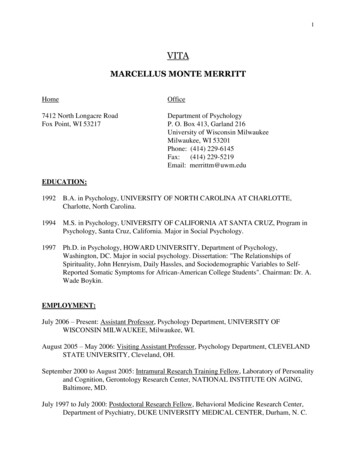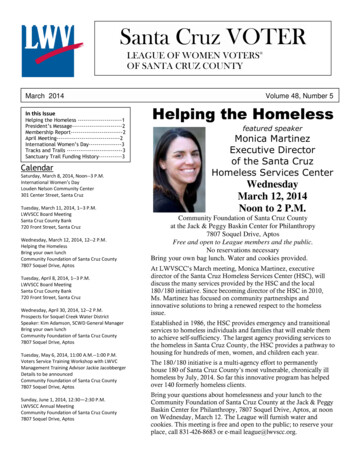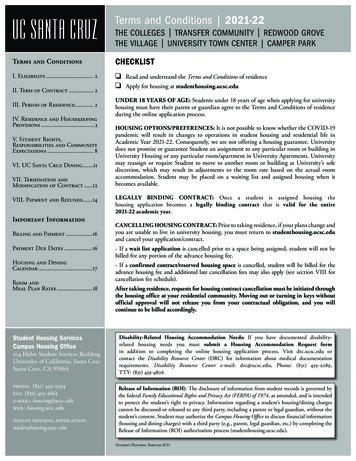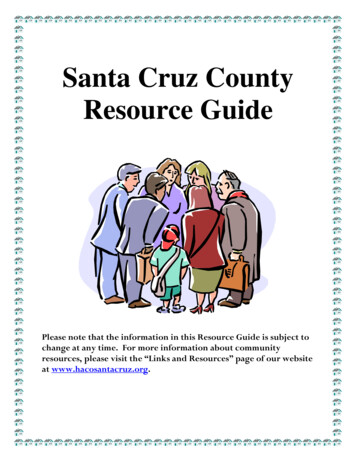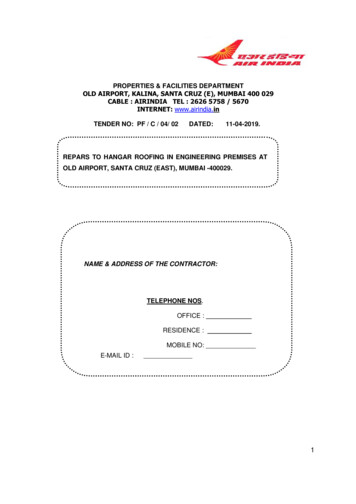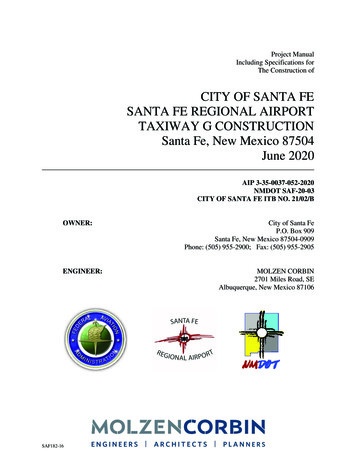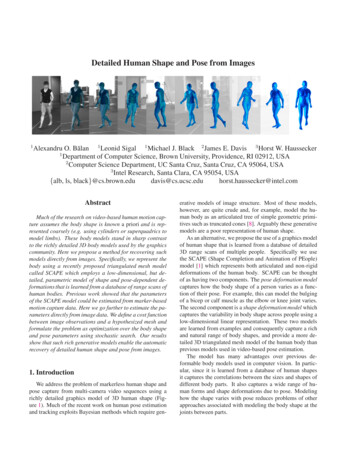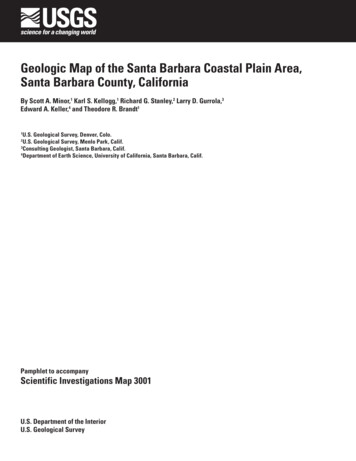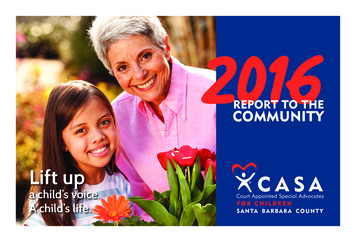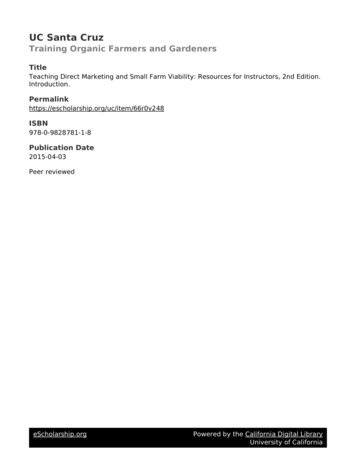
Transcription
UC Santa CruzTraining Organic Farmers and GardenersTitleTeaching Direct Marketing and Small Farm Viability: Resources for Instructors, 2nd ion Date2015-04-03Peer reviewedeScholarship.orgPowered by the California Digital LibraryUniversity of California
UCSC Farm & Garden ApprenticeshipUniversity of California, Santa CruzTeachingDirect Marketing &Small Farm ViabilityRESOURCES for INSTRUCTORSEdited by Jan Perez, Martha Brown, and Albie MilesA COMPANION VOLUME TOTeaching Organic Farming & GardeningRevised & Expanded2ND EDITION
The Center for Agroecology & Sustainable Food Systems is a research, education, and publicservice program located at the University of California, Santa Cruz. The Center’s missionis to advance sustainable food and agricultural systems that are environmentally sound,economically viable, socially responsible, nonexploitative, and that serve as a foundation forfuture generations.For ordering information contact:CASFS1156 High St.UC Santa CruzSanta Cruz, California 95064831.459-3240, N 978-0-9828781-1-8 2015 Center for Agroecology & Sustainable Food SystemsUniversity of California, Santa CruzSanta Cruz, Californiacasfs.ucsc.eduFirst edition published 2005Cover photo credits, clockwise from top left: Blue House Farm; Jon Kersey; Shauna Casey; CASFScollection; Abigail Huetter. Title page, lower right: Brandon Blackburn.No endorsement of names or suppliers is intended, nor is criticism implied of similar products or suppliers that are notmentioned or illustrated.
Table of ContentsPreface and AcknowledgmentsvContributors and ReviewersviiHow To Use This ResourceixAbout CASFS and the Farm & Garden ApprenticeshipxiiUnit 1.0 Small Farm Economic ViabilityUnit 2.0 Overview of Produce MarketingUnit 3.0 Community Supported Agriculture (CSA)12543Unit 3.0 Introduction to Community Supported Agriculture45Unit 3.1 CSA History57Unit 3.2 CSA Structure and Organization69Unit 3.3 CSA Outreach77Unit 3.4 CSA Administration109Unit 3.5 CSA Crop Planning117Unit 3.6 CSA Harvest and Post-Harvest Handling143Unit 4.0 Other Direct Marketing Options161Unit 4.0 Introduction and General Marketing Resources163Unit 4.1 Direct to Consumers—Farmers’ Markets andRoadside Stands169Unit 4.2 Direct to Restaurants and Retails189Unit 4.3 Additional Marketing Options197Unit 5.0 Marketing Basics213Unit 6.0 Building Resilience—Small Farm Planning & OperationsUnit 6.0 Introduction to Building Resilience—Small Farm227Planning and OperationsUnit 6.1 Building Resilience into Your Small Farm MarketingPlan, and Building Community with Social Media andOn-Farm Events239Unit 6.2 Dynamic Cash Flow Planning269Unit 6.3 Basics of Bookkeeping, Farm Taxes, andSpecial Tax Issues—Value-Added and Perennials283Unit 6.4 Case Study Discussion—Instructor’s Guide313
Unit 7.0 Food Safety on the FarmUnit 8.0 Farm Employees and Innovative Modelsfor Interns and ApprenticesUnit 9.0 Land Tenure Options and StrategiesGeneral Resourcesiv Teaching Direct Marketing & Small Farm Viability319349371391
Preface and AcknowledgmentsThe first edition of Teaching Direct Marketingand Small Farm Viability: Resources for Instructors was published in 2005 as a complement toTeaching Organic Farming & Gardening: Resourcesfor Instructors (published in 2003, with a new editionproduced in 2015). Direct marketing through outletssuch as Community Supported Agriculture projectsand farmers’ markets often goes hand-in-hand withthe type of small- to medium-scale, organic, mixedspecialty crop operations that many of the studentsin UC Santa Cruz’s Apprenticeship in Ecological Horticulture and other beginning farmers are interestedin developing. Issues of small farm viability and landtenure are also of particular interest to beginningfarmers, and the first edition of the manual addressedthose topics as well.As reflected in this second edition, learning how to access direct markets is more relevant than ever. Directmarketing and local food venues, key outlets for smallscale farmers, have grown exponentially in the past decade. In 2002, there were 3,137 farmers markets in theU.S.—by 2014, there were 8,268.1 Interest in locallygrown foods has blossomed: the National RestaurantsAssociations survey of chefs notes that local food has“ . . . topped the list of most important menu trends. . . .” for the past few years.2 The federal government,through the USDA, is promoting these local and moredirect marketing venues through the program called“Know Your Farmer, Know Your Food,” which supports local and regional food systems across the U.S.3Not only is direct and local marketing now a standardand evolving practice, but there continue to be newfarmers and new organizations helping people get intofarming. The USDA’s Beginning Farmer & RancherDevelopment Program, a significant funder of this1 Agricultural Marketing Service, USDA. 2014. Farmersmarkets and local food marketing: National count offarmers market directory listing graph-1994-2014.www.ams.usda.gov/AMSv1.0/2 Willis, Kendra. 2013. Locally-sourced food dominatesNational Restaurant Association’s top trends list for 2014.Extension, Michigan State University. msue.anr.msu.edu/news/locally sourced food dominates national restaurantassociations top trends3 USDA. 2013. Know your farmer, know your food—Our mission. www.usda.gov/wps/portal/usda/usdahome?navid KYF MISSIONtraining manual project, has spent over 70 millionbetween 2009 and early 2014 on programs to benefitbeginning farmers and ranchers.4This manual was written, and updated, to assist farmereducators in their work. It is designed to serve – Instructors at college and universities, agriculture organizations, farm-training programs, andapprenticeship programsAgricultural Extension personnelFarmers with interns or apprentices Growers, teachers, and organizers at urban farms,community gardens, and food projects with directmarketing outletsThis new edition is organized into nine units and hasbeen revised and expanded to focus more specificallyon the needs of the beginning farmer—targeting thebasics of what she or he needs to know to have a successful farm operation.All of the lectures and resource sections have beenupdated, and new units added on topics of particularimportance to beginning farmers, including unitson hiring labor and developing apprenticeships, addressing food safety, and implementing the basics ofmarketing (particularly the use of social media). Someof the primary updates reflect changes in marketingchannels, with new information on retail, agritourism, eCommerce, food hubs, institutional markets,collaborative efforts, farm dinners, and marketing tofaith-based communities. Also updated and expandedare the core elements of the original manual, includingbusiness planning, managing cash flow, direct marketing through Community Supported Agriculture (CSA),farmers’ markets, roadside stands, and restaurants, aswell as various land access strategies.Similar to the original edition, this new version’s unitswere written by staff and guest lecturers of the Apprenticeship in Ecological Horticulture at UC Santa Cruz,along with other invited experts (see Contributorsand Reviewers, page viii). Thus, the manual providesa bounty of timely, useful information for educatorsand beginning growers.4 National Sustainable Agriculture Coalition. 2014. Fundingrestored for beginning farmer training programs! NSAC’sBlog. face and Acknowledgments vTeaching Direct Marketing & Small Farm Viability
This manual and Teaching Organic Farming & Gardening: Resources for Instructors are both availablethrough our website at casfs.ucsc.edu/about/publications for free download in PDF format (as individualunits or the entire text). Print versions can be purchased at cost through the Center for Agroecology &Sustainable Food Systems (CASFS). It is our intentionthat these instructional materials be used as widelyas possible for education and training. We also planto update and add materials to both the web-basedand printed versions in the future, and we encourageeducators to visit the website to offer evaluation andto send us instructional materials that may be of usein future revisions.The development of this new resource was made possible with funding from Western SARE, Gaia Fund,True North Foundation, and the USDA BeginningFarmer and Rancher Development Program. The firstedition in 2005 was also supported by the Foundationvi Preface and AcknowledgmentsTeaching Direct Marketing & Small Farm Viabilityfor Sustainability and Innovation, and the OrganicFarming Research Foundation.This training manual represents the experience andwork of many people. The authors and reviewers arelisted on the Contributors page. The overall directionfor the manual was devised by Jan Perez and MarthaBrown. Jan Perez was the primary coordinator, working with authors to design and finish their drafts.She oversaw field-testing of curricula, and wrote orcontributed to many of the units. Martha Brown alsoprovided coordination and direction with two units,and oversaw the book’s editing and production. Wethank Jane Bolling of Jane Bolling Design for creatingthe beautiful cover design and updating the format,and Amy Bolton for her expertise in laying out andproofing the text. We also thank CASFS grant writerAnn Lindsey for bringing in the funding for the projectand helping to shape and guide it along the way, andDaniel Press, CASFS Executive Director, for his support throughout the project.
Contributors and ReviewersCONTRIBUTORSMartha Brown (Editor)Martha Brown, the Center’s Principal Editor, writes,edits, and designs the Center’s publications, alongwith managing the Center websites and other outreachefforts.Cathy Carlson (Food Safety on the Farm)Cathy of Carlson Food Safety Consulting works withproduce growers providing assistance with risk assessment, customer audit preparation and employee training to farms of all sizes. She is a Food Safety CommitteeMember at Hartnell College and a Farmer Fellow withEco-Farm. Previous roles include Food Safety ProgramManager at Community Alliance with Family Farmers,QA and Food Safety Manager at Fresh Leaf Farms,project manager at California Organics; and projectmanager at the US Department of Agriculture.Tina Cosentino (Overview of Produce Marketing,Marketing Basics)Tina Cosentino is the Purchasing Manager at VeritableVegetable, the first all organic wholesale produce company in the U.S. She grew up packing apricots to sellat her family’s retail market, “Cosentino’s” which wasa successful family business in San Jose, CA for over65 years. She has spearheaded farmer education programs in California, Mexico and Ecuador. Tina holdsan MBA in Agribusiness from Santa Clara Universityand a BS in Environmental Studies from UCSC.Poppy Davis (Building Resilience—Small FarmPlanning & Operations)Poppy Davis worked eight years at the USDA, most recently as the National Program Leader for Small Farmsand Beginning Farmers and Ranchers. Previously shewas a CPA with an emphasis in agricultural enterprisesand non-profits. She holds a Juris Doctor from DrakeUniversity Law School, a Masters in Journalism fromGeorgetown, and a BS in Agricultural Economics fromthe University of California at Davis.Raman Maangat (Food Safety on the Farm)Raman Maangat is the Food Safety Program Manager at the Community Alliance with Family Farmers(CAFF). She grew up on a diverse horticultural operation in British Columbia and moved to California in2011. Her practical experience combined with herdegree in Food Science from the University of BritishColumbia has enabled her to work with growers andthroughout the supply chain to develop plans for various operations.Liz Milazzo (Community Supported Agriculture)Liz Milazzo has been the Field Production Managerfor the Center since 2007, where she also teaches rowcrop and CSA production skills. Prior to joining theCenter’s staff, she managed the field production at ZenCenter Green Gulch Farm in Marin County for 7 years.She has gardened and farmed in the Bay Area for 25years, growing fresh vegetables for diverse markets.Albie Miles (Editor; Community Supported Agriculture,Other Direct Marketing Options)Albie Miles was the original editor for TeachingDirect Marketing & Small Farm Viability: Resourcesfor Instructors, and is now Assistant Professor ofSustainable Community Food Systems at the Universityof Hawaii, West Oahu. He received his PhD inEnvironmental Science, Policy and Management fromUC Berkeley.Sky De Muro-Miller (Community SupportedAgriculture)Sky De Muro-Miller is a Garden Instructor at theUCSC Farm & Garden, where she helps manage theAlan Chadwick Garden. She also organizes and teachesworkshops for the public and for beginning farmerson the Central Coast.Doug O’Brien (Overview of Produce Marketing)Doug O’Brien owns and operates Doug O’Brien Agricultural Consulting, which provides on-site technicaladvice, field monitoring, and research for fresh producegrowers and shippers in the Monterey Bay Area. Doughas a PhD in plant pathology and was an assistant farmadvisor. He also has experience in farming and ownedan organic produce brokerage.Jessica Beckett Parr (Community Supported Agriculture)Jessica Beckett Parr is the Foundation Program Manager for the California Certified Organic Farmers(CCOF) Foundation. She holds a MSc in CommunityDevelopment from UC Davis where she worked withprofessor Ryan Galt and a team researching CommuContributors viiTeaching Direct Marketing & Small Farm Viability
nity Supported Agriculture (CSA) in the Central Valleyof California. In her position with CCOF she organizesa diverse set of educational and support programs andevents for farmers and consumers regarding organicagriculture.Jan Perez (Editor; Other Direct Marketing Options)Jan is an Associate Specialist in Social Science Researchand Education at the Center. She has been conducting research and evaluation on programs and socialissues in the food system at the Center since 2001. Shereceived an MS in adult education from the Universityof Wisconsin, Madison.Kristin A. Reynolds (Small Farm Economic Viability)Kristin is an adjunct faculty member at the New Schoolfor Public Engagement in New York City and she alsoteaches at the Yale School of Forestry and Environmental Studies. She received her PhD in Geography andMS in International Agricultural Development fromUniversity of California, Davis. Her current researchexplores urban agriculture, social justice in the foodsystem, and action research. She has also worked atthe UC Small Farm Program and has lived and workedon small scale family farms in California, New York,and France.and vegetable horticulture and farm management atCornell University, and now owns a 50-acre farm inGranby, Massachusetts. Ryan was the original authorof this section.Eric Winders (Land Tenure Options and Strategies)Eric Winders is Development Program Manager forCalifornia FarmLink. With FarmLink since 2009, hepreviously served as Central Coast Regional ProgramCoordinator, providing farmers and landowners alongCalifornia’s Central Coast with technical assistanceand education on land tenure, financing, and businessdevelopment. He has a Master’s in EnvironmentalSciences and Policy, with a focus on small farms, andhas spent much of his life working in agriculture andhorticulture, including work in New York, Costa Rica,and Spain.REVIEWERSMarisa Alcorta is the General Manager for PieRanch’s 200-acre farm expansion project located inPescadero, CaliforniaAnn Baier is a Program Specialist in California forthe National Center for Appropriate Technology.Steve Schwartz (Other Direct Marketing Options,Land Tenure Options and Strategies)Steve Schwartz founded the Interfaith Sustainable FoodCollaborative in 2012 and California FarmLink in1998. He has over 20 years of experience in the fieldsof sustainable agriculture, rural development, environmental conservation, and microfinance, as well asgeneral program management, community organizing,public policy and fundraising. His faith communityorganizing includes work with Jewish, Christian, andBuddhist congregations. He has presented numerousworkshops on the use of conservation easements forfarm transitions, farm succession planning, and innovative financing techniques for farm purchases.Jo Ann Baumgartner is Director of the Wild FarmAlliance, Watsonville, CaliforniaNancy Vail (Community Supported Agriculture)Nancy Vail is co-founder and co-director of Pie Ranch,an educational farm in Pescadero, California. From1998–2008 she managed the UCSC Farm’s communitysupported agriculture program and taught row cropproduction, orchard management, and marketingskills.Nancy Vail, (see Contributors)Ryan Voiland (Farmers’ Markets and RoadsideStands)Ryan Voiland has been farming since he started hisown business growing certified organic vegetables inhis parents’ yard when he was 14. He studied fruitviii Contributors and ReviewersTeaching Direct Marketing & Small Farm ViabilityTina Cosentino (see Contributors)Poppy Davis (see Contributors)Elizabeth Henderson is a co-author of Sharing theHarvest, Revised and Expanded: A Citizen’s Guideto Community Supported AgricultureReggie Knox is the Executive Director of CaliforniaFarmLink, Santa Cruz, CaliforniaNeil Thapar is a Staff Attorney at the SustainableEconomies Law Center, Oakland, CaliforniaEric Winders (see Contributors)Note that this list acknowledges Contributors andReviewers to the first edition, as well as the currentedition.
How to Use This ResourceTeaching Direct Marketing and Small FarmViability: Resources for Instructors providesresources for teaching a variety of skills andtopics related to small farm viability, including optionsfor direct marketing, business planning, issues relatedto labor, apprenticeships, food safety, and land tenureoptions. It also offers an overview of small farmviability and produce marketing in the U.S. to giveagriculture students, farm apprentices, and othertrainees a context for the challenges that small-scalegrowers face in developing an economically viablefarming operation.This teaching manual is a companion volume toTeaching Organic Farming and Gardening: Resourcesfor Instructors, a largely production-oriented andfield-based resource that includes natural scienceand social science course material for sustainableagriculture instruction (see more at casfs.ucsc.edu/about/publications).This nine-unit manual is designed so that units orindividual lectures can be used on their own or in anysequence. The theme and content of each of the nineunits are described immediately below, followed by adescription of the different components of the units.Unit 1. Small Farm Economic ViabilityThis unit provides the context for subsequent studiesof the economics of small-scale agriculture. Followingan overview of the trends and factors affectingthe economic viability of small-scale agriculturein the U.S., the unit addresses the history of U.S.agriculture’s economic development, the social andeconomic factors affecting small farm viability, andthe barriers small-scale growers face to achievingeconomic success. It concludes with a brief reviewof short-term economic strategies and long-termpublic and private sector strategies geared towardmaintaining small farms as part of the Americanagricultural system.Unit 2. Overview of Produce MarketingThis unit introduces students to the history ofproduce marketing in the U.S. and discusses growers’most common marketing options. The historicaloverview reviews the changes growers made to theirmarketing practices after the advent of supermarketsand 20th century technology, such as refrigeratedshipping and storage. Three main marketing options(wholesale buyers, grower/shipper/packers, andbrokers) are introduced, stressing the advantagesand disadvantages of each. The unit also discussesdevelopment of a marketing strategy and includesan overview of three alternative marketing options(direct to retail, farmers’ markets, and communitysupported agriculture), which are covered in detail insubsequent units.Unit 3. Community Supported Agriculture (CSA)The six sections of this unit on direct marketingthrough Community Supported Agriculture addressmultiple aspects of the CSA model. The unit openswith a section on the history of CSA, introducingprinciple figures and the economic and social valuesthat have directed the development of this modelof sustainable agriculture in Europe, Japan, NorthAmerica, and beyond. It includes a discussion ofhow CSAs have changed over the past decade, from“membership” farms to “subscription” models.Subsequent sections address the practical aspects ofdeveloping and managing CSA operations, includingCSA organization, outreach, administration, cropplanning, and harvest and post-harvest crop handling.Unit 4. Other Direct Marketing OptionsThis four-part unit includes sections on a number ofcreative marketing options that small-scale producersare using to maintain the economic viability of theiroperations, and addresses the rewards, challenges, andtechniques for cultivating marketing outlets. Theselectures address the strategies for cultivating directmarketing outlets such as farmers’ markets, roadsidestands, eCommerce, agritourism and faith based options. This unit also covers what have been traditionally considered intermediate marketing options, suchas restaurants, retail, institutions (schools, colleges,hospitals, etc.), food hubs and collaborative ventures.Unit 5. Marketing BasicsThis unit addresses the standard 4 P’s of marketing:Product, Place, Price and Promotion, and reviewsthe steps for communicating who you are as afarmer. It starts by asking farmers to think abouttheir desired market channels and target audience,then some brief steps for evaluating the demand foryour product. Much of the unit focuses on how toHow to Use this Resource ixTeaching Direct Marketing & Small Farm Viability
develop a brand and value proposition, and how tocommunicate that to the target customer segment,including basic instructions on developing a websiteand using social media.ing, community land trusts, and leases to nonprofits.It also provides specific information to new farmersabout how to find a piece of land to rent or purchase,and how to execute a fair lease.Unit 6. Building Resilience—Small Farm Planningand OperationsThis five-part unit provides a comprehensive overviewof the business side of the farming operation, includingpractical advice on how to approach it. Using a casestudy to demonstrate the need for thoughtfulness andplanning, it covers the steps for creating a resilientand successful farm by developing a business plan thatintegrates a crop plan, marketing plan, financial planand a time plan. It also explores using social mediaand farm dinners as two different strategies that canbuild resilience. Finally, it addresses important business basics about cash flow planning, bookkeeping,and taxes.UNIT COMPONENTSUnit 7. Food Safety on the FarmThis unit introduces the topic of food safety on thefarm, and why it has become an increasingly importantissue for growers. Lectures review the various sourcesand types of microbial contaminants and the “goodagricultural practices (GAPS)” approach to evaluatingpotential risks and developing a food safety plan. Theunit includes examples of logs, checklists, and othertools used in assessing and minimizing the risks ofmicrobial contamination, and discusses the importanceof maintaining biological diversity in light of foodsafety concerns.Unit 8. Farm Employees and Innovative Models forInterns and ApprenticesThis unit covers the basic information about having employees on a farm. Although most beginningfarmers will start out by using just their own labor, asthey expand they often need to bring in help. Topicsaddressed include employee protections under federaland California state labor laws, and the basics that arerequired for doing taxes and complying with otherregulations. This unit also outlines different types ofworking relationships often used by farmers, such ashiring contractors, interns, and apprentices, and discusses ways to set up a legal apprenticeship program.Unit 9. Land Tenure OptionsThis unit introduces a range of strategies that farmerscan use to identify and secure long-term and affordableaccess to agricultural land. Along with cash rental,lease, and crop-share arrangements, it reviews a rangeof innovative approaches such as partnership options,owner financing, conservation easements, land pool-How to Use this Resource xTeaching Direct Marketing & Small Farm ViabilityEach unit in this manual contains multiple components and is designed for use by both the instructorand students. Note that not all units contain all of thecomponents outlined below.The units are designed with some or all of the following components:Introduction—An overview for use by both instructorand studentsIn the Introduction, the Unit Overview summarizesthe unit and briefly describes the information to beconveyed through the lecture(s) and (in some units)student exercises, as well as the approximate time forthe activities.Lecture Outlines—Instructor and student outlinesthat guide presentations and discussionsThe lecture outlines provide a broad but comprehensive overview of a given subject, identifying many ofthe key concepts within a given discipline that maybe addressed in an introductory lecture. Instructorsare encouraged to adapt the content of the lecture tospecific audiences or settings. Some units have onelecture outline and some have several. We suggestthat the instructor give copies (or electronic versions)of the lecture notes to the students before the lecture.Step-By-Step Sheets—For student useThese detailed “how-to” instructions walk studentsthrough tasks such as developing a cash flow projection and assessing the economic viability of a farming operation or developing a crop plan for a CSAoperation. The step-by-step sheets contain referenceinformation for students to use when working independently. Intended to be provided with Student Exercisesdescribed below.Student ExercisesThese activities or exercises reinforce student comprehension of the subject matter or skill by providingpractice following a lecture or demonstration.Resources and ReferencesThis section provides an annotated list of books,periodicals, websites, and other electronic resources,videos, and organizations that offer ideas and information for implementing the concepts presented inthe unit or provide resources for further study. Based
on their relevance to the material, the same resourcesmay be listed in more than one unit. In some instancesthe section may include material cited in the lectures.Appendix SectionThe appendices provide tables, graphs, charts, studentexercises, and other material to use as visual aids inlectures and demonstrations, or as reference materialsfor student exercises.Online ResourcesEach of the units in this manual is also available online as a .pdf. Also online are the various Excel filesreferenced in Unit 6. We will continue to add materialto the online materials at: casfs.ucsc.edu/about/publications. Look for the Teaching Direct Marketing andSmall Farm Viability: Resources for Instructors link.How to Use this Resource xiTeaching Direct Marketing & Small Farm Viability
The Center for Agroecology & Sustainable FoodSystems, and the Farm & Garden ApprenticeshipThe Center for Agroecology and SustainableFood Systems (CASFS, the Center) is a research,education, and public service unit of the Division of Social Sciences at the University of California,Santa Cruz, dedicated to increasing ecological sustainability and social justice in the food and agriculturesystem. Center research and education efforts seek toincrease understanding of the social, economic, political, and ethical foundations of agricultural sustainability; to establish the ecological and agronomic basis forsustainable production systems; and to demonstrateand facilitate the use of information critical to theadoption of sustainable food and agriculture systems.The Center’s work covers a spectrum that includesacademic education and practical training, theoreticaland applied research, and public service for audiencesranging from international grower groups to localschool children. The Center’s 3-acre Alan ChadwickGarden and the 33-acre UCSC Farm are unique organicdemonstration, education, and research sites on theUCSC campus.The Farm & Garden Apprenticeship is a six-monthtraining program held annually at the Center’s farmand garden sites. Initiated by Alan Chadwick in 1967,this full-time course now brings participants of all agesfrom around the world to learn the basic skills of organic gardening and farming, while also studying thecomplex social and environmental issues surroundingsustainable agriculture and food systems. The programcombines classroom instruction, small group demonstrations, and readings with hands-on learning in thefields, gardens, greenhouses, and orchards. The maininstructors in the Apprenticeship course are the twoGarden Managers and the Field Production Manager,who work daily alongside the apprentices, presentclasses, and lead training sessions. UCSC faculty, researchers, and members of the agricultural and urbangardening community add a wide range of expertiseto the course.To date nearly 1,500 apprentices have completed theApprenticeship training program. Graduates have established their own commercial farms and market gardens, run community gardens for inner city and prisonpopulations, and developed school garden programs.Many graduates take part in international develop-xii About CASFS/ApprenticeshipTeaching Direct Marketing & Small Farm Viability“There are very few programs that provide anacademic component to the ve
65 years. She has spearheaded farmer education pro-grams in California, Mexico and Ecuador. Tina holds an MBA in Agribusiness from Santa Clara University and a BS in Environmental Studies from UCSC. PoPPy Davis (Building Resilience—Small Farm Planning & Operations) Poppy Davis worked eight years at the USDA, most re -
